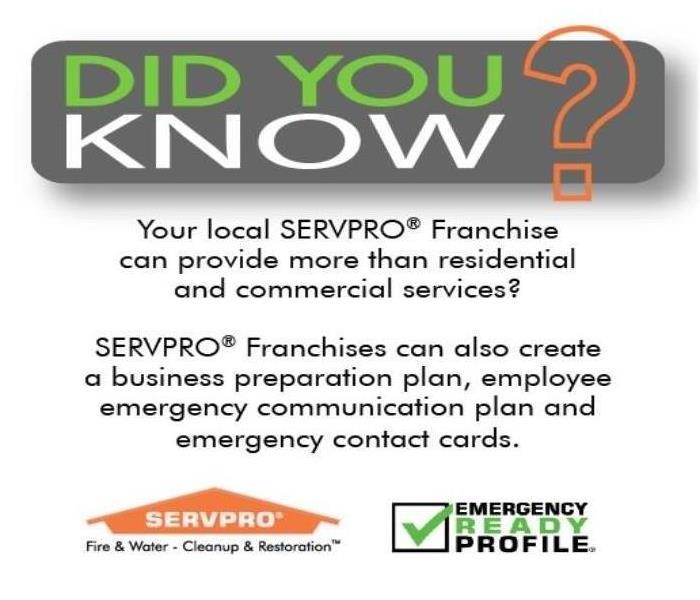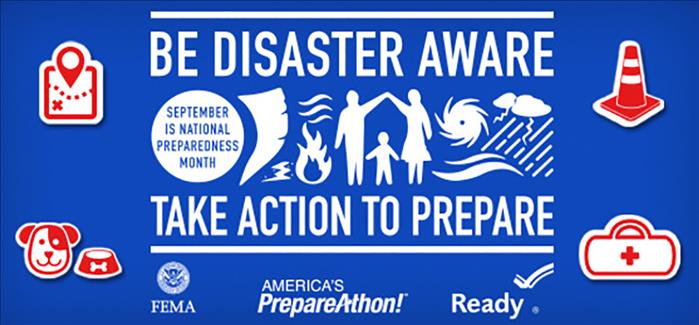Recent Community Posts
The Mobile Workforce Trend
9/5/2021 (Permalink)
Nowadays it would probably be easier and more convenient to go a day missing a hand than it would be to not have your cell phone. Mobile phones are literally the center of our life with reminders for appointments, alarms, contacts, emails, social media, bank information, and basically anything that you have going on in your daily life.
Naturally and inevitably, our careers and workplaces are being woven in with our mobile devices. The technology that we have begun to rely on has offered the opportunity to infuse the mobile workplace trend to businesses of all kinds and all over. This trend is a long time coming, and due to the COVID-era the popularity and need have sky-rocketed.
What is a Mobile Workforce?
A mobile workforce is a group of employees that isn’t bound by a central physical location. Instead, the employees are connected by various types of technology: computers, smartphones and other mobile devices.
Traditionally, the definition of a mobile workforce was synonymous with ‘work from home.’ However, with tech advances such as video conferencing and collaboration applications, the definition of remote working has expanded and increasingly includes employees that are out in the field - an estate agent signing off a mortgage, a lawyer briefing a client, or a sales rep closing a deal. All of these, together with those working from home, contribute to the mobile workforce.
Why use a Mobile Workforce?
In today’s world, working remotely has increased in popularity and in fact was the only option for a significant amount of time. Creating a mobile workforce gives employees the capability to access all needed databases and be able to stay connected with the team in using uniform systems.
A mobile workforce is also helpful to the younger generation who excel in the technological world. Studies have also shown that productivity is increased when work can be done from home or a space an individual can choose to use.
At SERVPRO we are a mobile workforce, not only in the technological sense but also in the way of having the capability to mobilize within minutes and arrive faster to any disaster 24/7.
We are here to help in the times that offices are needed to keep all employees and customers safe. Call today for any of your commercial cleaning needs 1-800-SERVPRO.
Giving Back
2/19/2019 (Permalink)
At SERVPRO we feel that it is important to give back to the community so we’ve partnered with our local insurance agents to support local domestic violence shelters. Every 9 seconds in the U.S. a women is assaulted or beaten. Domestic violence is the leading cause of injury to women- more than car accidents, muggings and rapes combined. 92% of women surveyed list reducing domestic violence and sexual assault as their top concern. In December of 2018 women in our industry came together to provide Christmas gifts to over 140 women in local shelters. The outpouring of support was staggering! We plan to continue the supporting domestic violence shelters by providing volunteer opportunities and continued donations. In May we plan to give jewelry and scarves to the shelters so the children can give them a moms a Mother’s Day gift. To all the generous women who have helped provide gifts for our local domestic violence shelters a special Thank You for your kindness and caring. We will continue to keep everyone updated on this cause which is very near and dear to all our hearts. Thank you!
Cyber Awareness
11/9/2018 (Permalink)
Why is SERVPRO concerned about creating community awareness regarding cyber attacks and cyber security? The more our world becomes connected to the internet the greater the risk for property damage. Consider the following scenarios:
- Hackers gain access to a steel mill via a phishing attack introducing malware to the control system that prevents the shutdown of a blast furnace causing massive damage.
- A power grid is remotely disabled by hackers causing extensive power outages.
- Using a homemade transmitter, a teenager trips rail switches and derails train cars.
- A hacker infiltrates the computerized waste management system and deliberately spills millions of gallons of raw sewage.
- Machines at a hospital are infected by malware and a remote-access program is installed on the hospital's HVAC system. This jeopardizes patient safety by putting drugs and other medical supplies at risk by altering the heating, AC and ventilation systems.
Sound like science fiction? They are all true incidents and it is predicted that as the IoT (Internet of Things) continues to expand, property attacks will become more prevalent and costly. Imagine hackers gaining access to the freezer temperature control at a frozen food manufacturer or infiltrating the computer system that regulates the fire sprinkler system in a large hotel. The focus on cyber security and providing appropriate cyber coverage for commercial customers is not only important to protect data but also to protect vital system functions. Hackers have only scratched the surface when it comes to property damage so it is important to educate yourself about cyber risks before a catastrophic incident occurs.
We're On Social Media !
5/2/2018 (Permalink)
SERVPRO of Northern Summit County is active on social media, and we would love for you to follow us!
On our social media pages, you can find relevant safety, cleaning, and remodeling tips, local and industry news, event information, before and after pictures of completed jobs, pictures of our crew, volunteer and fundraising campaigns, and more!
We are currently on Facebook, LinkedIn and Google+, with more platforms to come. Social media allows us to interact with our customers, local businesses, and industry partners in new and exciting ways. We love to hear your thoughts and feedback through social media, and we welcome comments on industry topics and content you would like to hear more about. Please click the links below and follow our pages to receive the latest updates from us!
Facebook
LinkedIn
Google+
Twelve Things you Can Do to Prepare for Spring
2/26/2018 (Permalink)
Done with Winter ? Prep for Spring ? Here are 12 things you can do to prepare your home.
- Clean your rain gutters.
Wind, animals, and gravity bring sticks, leaves, and other organic matter into your rain gutters, and chances are yours have accumulated their share of detritus over the winter. That's bad news for your home: When downspouts are clogged, rainwater can spill out of your gutters and around the perimeter of your house, putting it at risk for leaks and flooding. Get ready for spring showers by removing the mess from your gutters to ensure that the water will flow freely. Check out our blog post Rain Gutters and Water Problems for clues you may have a problem. - Change filters.
To maintain optimal air quality in your home, it’s a good idea to replace your HVAC system's air filter seasonally as well as the filter in your kitchen range hood. While you're at it, consider changing the filters in your water purification system. Depending on your water, you might not need to change these as often as your HVAC filters, but it's not a bad idea to check them now. So, go ahead and welcome spring with new filters all around to keep your home clean and fresh, and your appliances in good working order. Need help ? See what SERVPRO of Northern Summit County can do to help with our Air Duct and HVAC Cleaning Services.
- Check vents.
As snow melts away from your home’s foundation, it’s a good time to check any vents along the foundation or in the attic. Look for missing or damaged screens, debris, signs of insect or rodent infestation, or other issues, and correct them before they have a chance to become bigger problems later in the season. - Service the Lawn Mower.
Get your lawn mower ready for the season with a tune-up. If you didn’t do it in the fall, now’s the time to drain and replace oil, sharpen the blades, remove caked-on grass and mud, and lubricate moving parts. - Prep the gas grill.
After a long winter spent cooped up indoors, you're probably eager for a sunny day and a burger hot off the grill. Get your outdoor cooking station ready for spring by scraping away any rust spots that developed over the winter, cleaning the grill inside and out, and checking the fuel tank hose for damage. - Clean Backyard Furniture
As the weather warms up, outdoor entertaining may be just around the corner. Prepare for warmer days ahead by thoroughly hosing down all backyard furniture—chairs, tables, and lounge chairs—wiping away cobwebs, and bringing outdoor chair cushions out of winter storage.
- Pamper the Lawn
Once the danger of frost has passed and your grass starts to come out of winter dormancy, it’s time to jump-start your spring lawn-care routine. Address winter damage to your turf by seeding bare patches—although if you do reseed at this time of year, you should avoid spring applications of chemical weed or crabgrass treatments, which can harm new grass. Then get a head start on weed prevention by manually removing broad-leaf weeds before they have a chance to multiply. For cool-season grasses, spread a light application of fertilizer in early spring; for warm-season grasses, fertilization can wait until late spring or early summer.
- Groom Shrubs and Trees
Winter storms can be hard on your landscaping, resulting in broken tree limbs, ragged shrubs, and a garden full of organic debris. Get your yard ready for spring by removing broken or damaged branches, pruning summer-blooming trees and shrubs like butterfly bush and crepe myrtle, and raking up fallen leaves. For information on our Storm Damage services, click here.
- Check the Roof
Take advantage of the sun’s return to check your roof for cracked or missing shingles or tiles, and examine flashing around vents and the chimney for damage. While you’re at it, have the chimney cleaned and inspected by a professional.
- Plant Bulbs
Spring is the ideal time to plant summer-blooming flowers, which include beauties like dahlias and gladioli. Go ahead and get them into the ground as soon as the danger of frost has passed.
- Clean Windows
Winter storms and rain can leave your windows streaked and dirty. Improve your view of mellower weather and let more sun into the house by cleaning windows, both inside and out. Storm Damage ? Click here.
- Test Alarms
Let the change of season be your reminder to test all smoke alarms and carbon monoxide detectors for proper functioning. Change batteries if necessary. Alarms can malfunction as they age, so if yours are older than seven years, consider replacing them.
Happy Spring, Summit County ! In need of SERVPRO of Northern Summit County services ? Questions ? Visit our website or call us at - 330-650-4486
Call SERVPRO of Northern Summit County
11/29/2017 (Permalink)
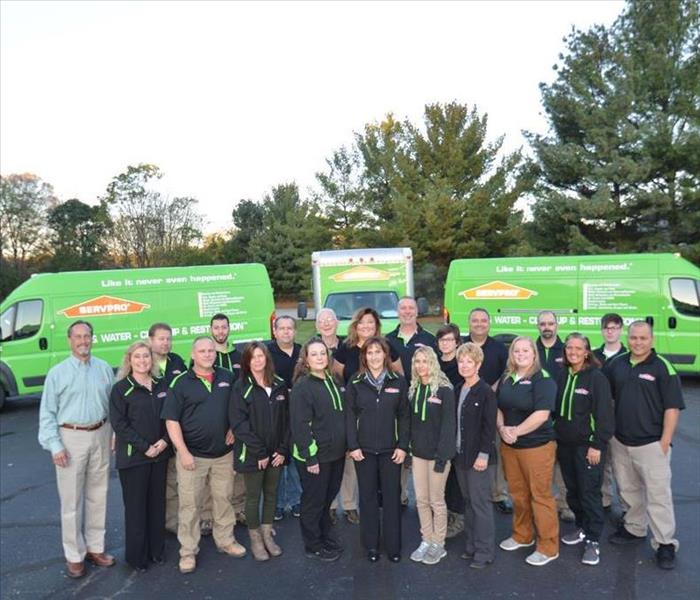 Our franchise professionals are uniquely qualified to help. Need Help? Call our 24/7 Emergency Service line at 330-650-4486
Our franchise professionals are uniquely qualified to help. Need Help? Call our 24/7 Emergency Service line at 330-650-4486
SERVPRO of Northern Summit County understands the stress that comes with damage to your home or business, whether it be from fire, water, mold, storm or even biohazards. Our franchise professionals are uniquely qualified to help.
Our team is trained to IICRC standards in fire and water cleanup and restoration. In addition, we have Employee Certification Training, Initial Franchise Training, e-Learnings and Continuing Education Classes. For more information on our training program, click here.
Restoring your property is SERVPRO's first priority, and restoring your property is less expensive than replacing your property.
We respond immediately to your loss with our 24/7 Emergency Service team. With over 1,700 U.S. and Canadian Franchise locations, SERVPRO is strategically positioned to be faster to any size emergency. An immediate response helps to minimize the damage and the cleaning and restoration costs.
For more information on SERVPRO of Northern Summit County, visit our Company Profile page.
Need Help? Call us at 330-650-4486, or Request Help Online.
Overcoming Hoarding: 12 Tips
8/22/2017 (Permalink)
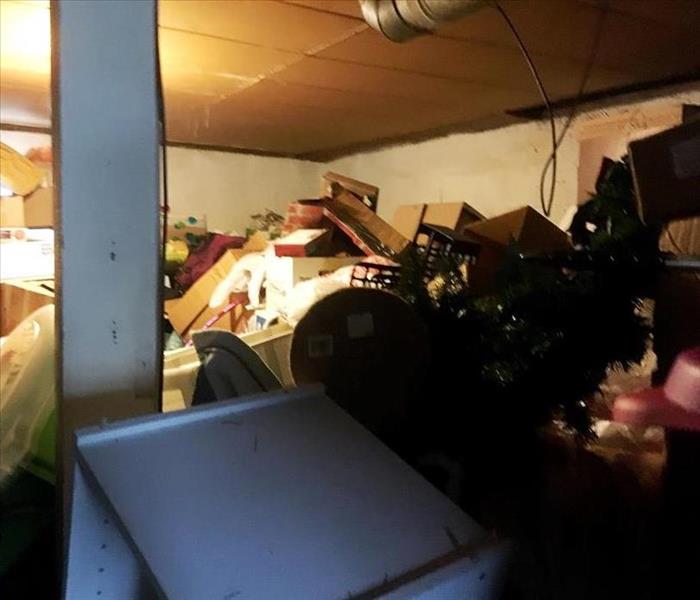 There’s obviously the assault on your eyes of the quantity of the clutter, then there’s the appreciation of what a mishmash the clutter is. -WebMD
There’s obviously the assault on your eyes of the quantity of the clutter, then there’s the appreciation of what a mishmash the clutter is. -WebMD
Compulsive hoarding, also known as hoarding disorder, is a persistent difficulty discarding or parting with possessions because of a perceived need to save them, according to MayoClinic.org. Excessive accumulation of items, regardless of value, occurs.
People with compulsive hoarding may not see it as a problem, and this makes treatment challenging. Below are some tips to overcoming hoarding, pulled from Oprah.com:
- Just because you can think of a use for an object, doesn't mean you need to keep it. If you haven't used an object in over a year, if you didn't know you had it until you found it, you can probably live without it.
- More is not necessarily better. Try to get rid of the extras.
- Categorize items into piles. A pile of things to keep, to donate, to sell or give away, and to throw away, but don't make too many piles and stress yourself out.
- Don't overthink. If the decision takes you more than a couple of minutes for a particular object, you're making it too complicated.
- Learn to get past the imperfections- you don't have to do a perfect job, just a good enough job.
- Only Handle It Once (OHIO). If you pick something up, make a decision and put it where it belongs.
- Be brave. The people who gain the most are usually those who are willing to risk the most.
- Understand what you're afraid of, and recognize when your fears are irrational. Ask yourself, what's the worst that can happen if I throw this out? How bad would that really be? Then discard it and watch for whether or not that bad thing happened.
- Be patient. No one overcomes compulsive hoarding overnight. Take it one room at a time.
- Keep the ball rolling. Clean things as they come along before they become overwhelming problems. Once you start, don't stop. Create a pattern, 5 minutes a day, 30 minutes...
- Be strict with yourself. Promise yourself a reward for doing it.
- Know when to ask for help. Compulsive hoarding is a potentially serious mental health issue. If you can overcome it on your own, great. If you can't, get help from someone who has experienced it.
For further information, visit WebMD.
Flash Flood Safety Tips
7/19/2017 (Permalink)
 When a river overflows, bridges, houses, trees and cars can be picked up and carried off.
When a river overflows, bridges, houses, trees and cars can be picked up and carried off.
While in the midst of storm and hurricane season, we feel it necessary to draw attention to some flash flood safety tips.
Firstly, here are some statistics on flooding to note:
- Flooding is the second leading weather-related cause of death
- 2 feet of water will move your vehicle. 6 inches of water will sweep you off your feet
Here are some safety tips to practice when experiencing a flash flood event:
- Get to higher ground and avoid low spots in the road or areas prone to flooding
- Never cross barriers that protect from flooded areas. If your vehicle stalls, abandon it immediately
- Flood dangers are harder to recognize at night
- Never cross water of unknown depth. Roads may be washed out
Keep watch of your local weather station for flooding and flash flooding threats.
Stay tuned for our next blog with "6 ways to protect your home from flooding."
Protecting Your Homes During the Summer Travel Season
7/6/2017 (Permalink)
 The average property dollar loss per burglary is a staggering $2,251. Take precautions before leaving your house unoccupied.
The average property dollar loss per burglary is a staggering $2,251. Take precautions before leaving your house unoccupied.
Before leaving your home alone for vacation time this summer, seek some risk identifications to unoccupied homes and steps necessary to mitigate them.
Burglary is, of course, the biggest risk, and home security systems provide exceptional safety and peace of mind. However, the homeowner still has a critical role in making sure his or her home and its contents are safe.
Do not broadcast your whereabouts and travel activities on social media. Criminals lurk online and are eager to burgle a home when they know the residents are away.
Make the home look occupied:
- If cars are normally left outside, have someone periodically drive them or move them around.
- If there is a swimming pool, keep the water in it circulating.
- Make sure that lawn mowing and watering continue as scheduled.
- Put a hold on mail and newspaper. Use timers on exterior lights to go on and off at the usual times.
Secure the home and its contents. Security systems can only do so much. Take extra precautions when you plan to be away:
- Add security lights with motion sensors to scare off potential burglars.
- Close all window latches and put a secondary blocking device such as a wooden dowel.
- Let the security company know when the home will be vacant.
- Lock the garage door manually.
- Move jewelry to a safe or bank safety deposit box.
- Do not leave keys in an obvious place.
- Lower the volume or shut off the ringer on telephones so they cannot be heard outside.
- Make sure fine art, expensive electronics and other valuables are not visible through windows.
- Put fresh batteries in smoke detectors so they remain operable.
- Deadbolt the doors.
Minimize the potential for damage. Some steps you can take to avert potential disasters include:
- Shutting off water lines.
- Making sure a sump pump in the basement is working properly.
- Making sure washing machines, dryers, and dishwashers are turned off.
- Unplugging small appliances and electronics to prevent damage from a power surge.
A watchful pair of eyes is the best defense, so ask a trusted neighbor to look in on things while you are away, to alert you and the police is there is anything suspicious. A house-sitting arrangement is worth considering for a long absence.
Tips to an Appropriately Floored Kitchen
6/14/2017 (Permalink)
Kitchens go through a lot, and having an appropriate floor to withstand the dirt, the grease, the falling heavy objects, and God knows what else, is extremely important to keeping the environment in check.
Here are some pros and cons to various types of flooring recommended for kitchens:
- Tile
- Quick and simple cleaning
- Withstands blows from heavy objects and scratches
- Multitudes of color options
- Over time, seams between individual fragments will clog with mud, difficult to clean
- Laminated Floors
- Simply washed by semi-dry cloth
- Attractive appearance
- Waterproof option
- Can withstand household chemicals, somewhat resistant to abrasive detergents
- Linoleum
- Easy cleaning
- No seams
- Waterproof
- Attractive appearance
- You get what you pay for
For further information, follow the link to read HGTV's Kitchen Floor Buying Guide: http://www.hgtv.com/remodel/kitchen-remodel/kitchen-floor-buying-guide
Getting Through a Power Outage
6/13/2017 (Permalink)
 Only use flashlights for emergency lighting, candles can cause fires.
Only use flashlights for emergency lighting, candles can cause fires.
According to Inside Energy Investigations, "the five-year annual average of [power] outages doubled every five years...: For 2000 to 2004, there were an average of 44 reported grid outages per year. From 2005 to 2009, there were an average of 100 reported grid outages per year. From 2010 to 2013 (a four year period), there were an average of 200 reported grid outages per year."
The following link will lead you to the source of information: http://insideenergy.org/2014/08/18/power-outages-on-the-rise-across-the-u-s/
Diesel Service and Supply names a few potential reasons for these outages:
- America's Aging Power Grid. In 2014, our electric grid was losing power more often than any other developing nation.
- Severe weather. Research suggests that 70-percent of power outages are caused by bad weather or natural disasters.
- Air-conditioning. The rising temperatures are not what cause the power outages. It is the number of people in the region running their air-conditions and fans, overloading the power grid, causing temporary or long-term blackouts.
- Wildlife. Animals interfering with electrical equipment accounts for about 11-percent of America's outages.
A sure way to avoid a blackout entirely is to purchase a quality generator. With the right kind of backup generator and routine maintenance, a power outage doesn’t have to mean lost business.
To read more on what Diesel Service and Supply has to say on this matter, click HERE.
September is National Preparedness Month
9/7/2016 (Permalink)
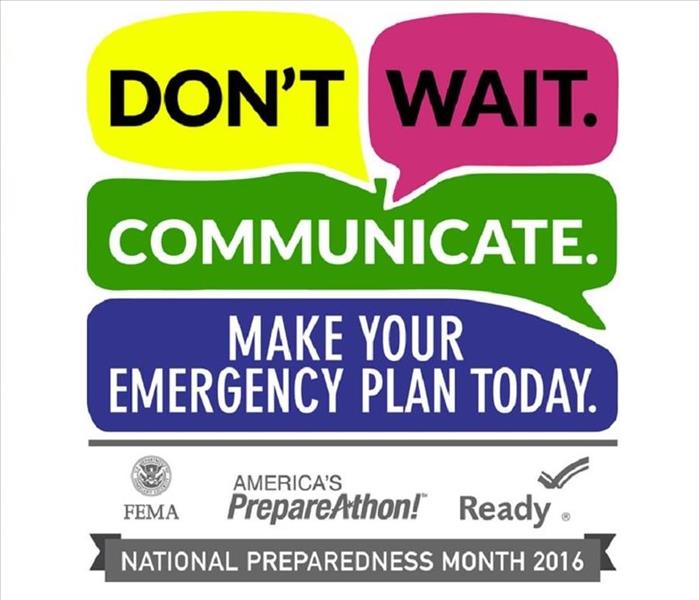 Consider ways that you can prepare for potential emergencies during National Preparedness Month
Consider ways that you can prepare for potential emergencies during National Preparedness Month
Did you know that September is National Preparedness Month? National Preparedness month encourages individuals be prepared for potential emergency situations. The more that you are prepared for the unexpected, the more equipped you will be to deal with situations quickly and effectively and to limit the damage. AT SERVPRO we understand the challenges and stresses of unexpected disaster. National Preparedness Month is a great time to put together readiness plans for potential emergency situations that could affect your home or business. It is a time to consider how your family could stay in touch if separated when an emergency occurs, how you can work together with your neighbors and community in a disaster situation, and how you can assist those who are particularly vulnerable during an emergency, such as children and older adults. The best way to mitigate a disaster is to be prepared! You can find lots of great resources at https://www.ready.gov/september.
September 1 Starts National Preparedness Month
9/2/2014 (Permalink)
Today is the first day of National Preparedness Month! This week will focus on How To reconnect with your family after a disaster? Make sure your family has a family emergency communication plan. How will you reconnect with each other? Where will you meet? What if your neighborhood is being evacuated? Communicating with your friends and family when a disaster occurs is important to make sure everyone is safe. This is why having both an evacuation and communication plan is important. Have peace of mind when a disaster strikes and create your evacuation and emergency communication plans. Ready to make a plan? Start today by visiting http://www.ready.gov/make-a-plan






 24/7 Emergency Service
24/7 Emergency Service


